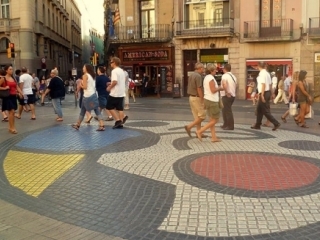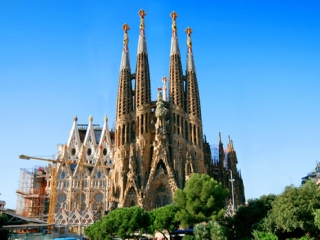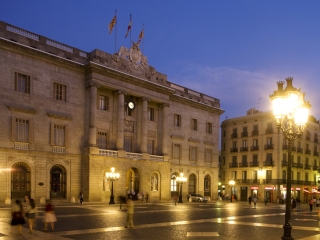
1. La Rambla
La Rambla is the most touristic street in Barcelona. This 1.2 kilometer long promenade lined with plane trees joins two of Barcelona's most important points: Plaça de Catalunya and Plaça Portal de la Pau with the column bearing the monument to Christopher Columbus. The promenade is crowded during the day and until late in the night. Most of the time there are many more tourists than locals occupying the Rambla. For this reason also it has become a prime target of pick pockets during day and night and agressive prostitutes during early morning hours.

2. Sagrada Familia
Sagrada Familia is a large Roman Catholic church which construction had commenced in 1882 and is still in progress. Although it was left incomplete at his sudden death, Sagrada Familia is considered Antoni Gaudi's masterpiece. Gaudi saw the Sagrada Familia as a great symbol that would represent the life of Christ in three monumental facades. At the time of Gaudi's sudden death in 1926, less than a quarter of the project was complete. During the years many of Gaudi's pupils and collaborators continued working on the construction based on Gaudi's sketches as many of his original plans were destroyed during the Spanish Civil War. Hence, there are two opposite opinions - the one supported by those who would like to see the church completed and those who would leave it as it is. Construction on Sagrada Família is not supported by any government or official church sources. It is financed by numerous donations and money from tickets purchased by tourists.

3. Gothic Quarter (Barri Gotic)
The Gothic Quarter (Catalan: Barri Gotic) is the center of the old city of Barcelona. The Barri Gotic retains a labyrinthine street plan, with many small streets opening out into squares. It encloses most of what remains of medieval Barcelona and includes some of the most interesting monuments in the city. The name of Gothic Quarter came into use in the early 20th century when it was realized that, although it is not the only area of the city, the complex of buildings remaining here is more harmonious and therefore deserving greater attention. Most of the quarter is closed to regular traffic although open to service vehicles and taxis.

4. Park Guell
Park Güell is a garden complex with architectural elements designed and built by the Catalan architect Antoni Gaudí between 1900 and 1914. The Park is situated on the hill of El Carmel in the Gracia district of Barcelona. It was built for the Catalan industrialist Eusebi Güell after whom the Parc was named. Today, the Park is converted in a municipal garden. Its structure, the mosaics and chimneys make it an authentic symbol of Barcelona. The entrance to the Park is free although Gaudi's house inside the Park can be visited only for an entrance fee. The Park is declared by UNESCO as a World Heritage Site.

5. Montjuic
The hill of Montjuic is one of the most interesting areas of Barcelona. It offers a relaxing area where both tourists and locals spend their leisure time. Along magnificent gardens, monuments, museums and other places which make it an irresistible attraction, Montjuic is also a place where numerous sports facilities were built for 1992 Olympic games. Funicular will take you from Parallel metro station to first level as part of ordinary metro ticket.

6. La Pedrera (Casa Mila)
Casa Mila (better known as La Pedrera) is a building situated on Passeig de Gracia in a L'Eixample district. It was designed by Antoni Gaudí and built during the years 1906–1912. It represents Gaudi's concept of nature and is a host of the most notable chimneys in the world. At the time La Pedrera was built it's design was quite controversial because of its bold forms of the undulating stone facade and wrought iron decoration of the balconies and windows. It is possible to make both day and evening tour of Casa Mila.

7. Parc de la Ciutadella
Large park placed close to Arc de Triumph. The Parc hosts the city ZOO, Parliament of Catalonia, several museums and amazing cascada fountain designed by Josep Fontsere. There are several statues in the park - the one that stand out most is a large stone mammoth. The parc represents favourite green area of the tourists and locals optimal for jogging, cycling, doing yoga, dog walking or just relaxing.

8. The Magic Fountain of Montjuic and Plaça Espanya
The Magic Fountain of Montjuic is one of the most famous tourist attraction of Barcelona. It is the main feature of collection of waterfalls which stretches from the Palau Nacional to Plaça Espanya. The Magic Fountain is very popular because of the spectacular show of water acrobatics, sound, colour, motion and lighting. Combination of these elements offers an amazing expirience and an excellent way to end a sighteeing day in Barcelona. The show runs for app 30 minutes and the music ranges from classical to modern. From October to April the Fountain operates on Fridays and Saturdays every half-hour between 7:00 and 8:30pm and from May to September on Thursday through Sunday every half-hour between 9:00 and 11:00pm. It is good to come early to get good position. The closest Barcelona Metro station is Espanya, along Lines 1, 3, and 8.

9. Camp Nou Football Stadium and Museum
As the Football Club Barcelona is one of the most successful clubs in terms of official titles won both in Spain and Europe, it is no surprise that the Camp Nou, the home of FC Barcelona, became one of the most famous and visited football stadium in the world. As Barcelona's previous stadium, Camp de Les Corts, had no room for expansion, in 1954 began the construction of the Camp Nou. The Camp Nou (meaning "new stadium") was officially opened in 1957. It is currently the largest stadium in Europe with a 98,000-seater capacity. Once it was the same size as the Maracana Stadium in Rio de Janeiro and the largest stadium in the world with capacity for 120,000 spectators but it has since been reduced in size for security reasons. The facilities of the stadium include a memorabilia shop, mini-pitches for training matches and a chapel for the players. The stadium also houses the second-most visited museum in Catalonia, FC Barcelona Museum, which receives more than 1.2 million visitors per year.

10. Port Vell, Port Olimpic and Barceloneta Beach
Barcelona's port is Catalonia's largest port. The Port Vell (the old port) is one of the three zones of the port which comprises two marinas/yacht harbors, a fishing port and station for ferries. In the central area the port houses a multiplex cinema, IMAX, Europe's largest aquarium and Maremagnum - shopping mall and nightlife complex - the only commercial mall in the city that can open on Sundays and public holidays.
